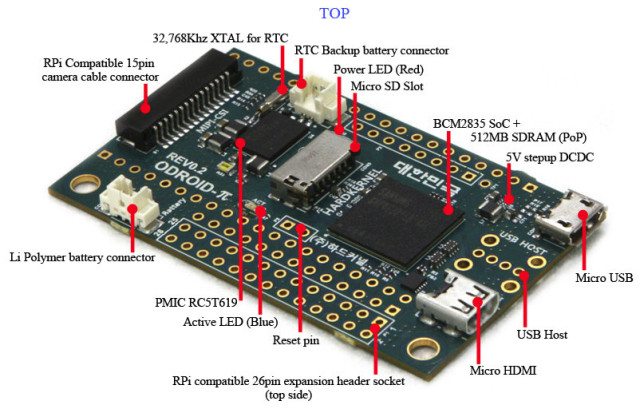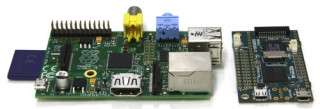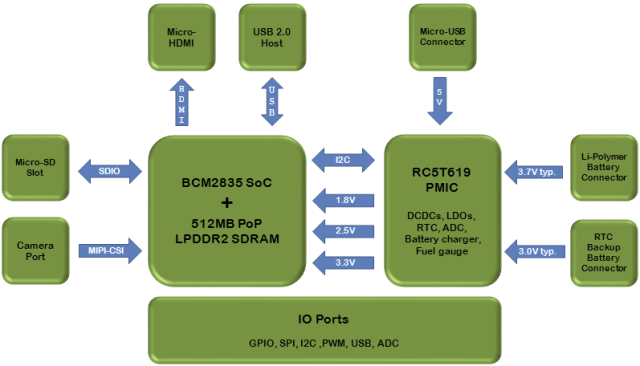Hardkernel is better know for its ODROID boards powered by Samsung Exynos SoC. So I was surprised to discover ODROID-W, “a miniature computing module which is fully compatible with all software available for the Raspberry-Pi”. Software compatible, really? Yes, because they used the same Broadcom BCM2835 SoC found in the Raspberry Pi, packaged it in a smaller form factor, while keeping HDMI, USB, and CSI interface, and expansion headers, and all that for $30, plus just $9 for shipping.

Let’s go through ODROID-W specifications first:
- SoC – Broadcom BCM2835 ARM1176JZ-F processor @ 700 Mhz with VideoCore IV GPU
- System Memory – 512MB LPDDR2 (Samsung K4P4G324EB PoP)
- Storage – microSD slot + eMMC socket (bottom of the board)
-

Raspberry Pi vs ODROID-W Video Output – micro HDMI (with NXP IP4791CZ12 protection IC)
- USB – micro USB connector, and USB host (not soldered)
- Expansion Headers:
- R-Pi compatible 26-pin expansion header (through holes)
- R-Pi compatible 15-pin CSI connector
- 20+6 -pin header for extra GPIO/ADC/Power and USB connection
- RTC backup battery connector (1.25mm pitch Header)
- Li-Po battery connector (1.25mm pitch Header)
- Misc – RTC
- Power
- Supply – Via micro USB or LiPo battery
- PMIC – Ricoh RT5T619 Power Management IC with step-down DC/DC Converters, low-dropout regulators, Real Time Clock, Li-ion Battery Charger, I2C-Bus Interface, Voltage detections, Thermal shut-down, and 12bit Analog-Digital Converter. (0 to 2.5V)
- Step-up DC/DC converter – TI TPS61259 . For battery-powered portable applications. Supports up to 1000-mA load current from a battery discharged as low as 3.4V. The 5 Volt output is used for USB host and HDMI circuitry.
- Voltage detector IC – Torex XC61FN2412MR for stable system start (Auto-power on) It includes Voltage detector and Delay circuit
- Dimensions – 60 x 36 x 7mm

Hardkernel created this board thanks to a request from a customer for a wearable platform. ODROID-U3 consumes too much power, and the Raspberry Pi was just too big. So they created a software compatible module for this purpose, which explains why we lose Ethernet, composite output, the audio jack, one USB port, and the DSI connector, and the SD card slot has been replaced by a micro SD slot, but keep everything else, and gain RTC, 2x ADC, LiPo, and eMMC socket, a few more GPIOs (32 in total), all into a much smaller form factor. Current documentation and resources include the schematics (PDF), the mechanical drawing files (DXF), Linux 3.12 source code with RTC, ADC, etc.. drivers, and ODROID-W Wiki.
The video below shows how you can solder the USB connector to the top or bottom of the boards, and boot the battery-powered board with Raspbian installed on the micro SD card. Nothat if you want network connectivity as well, you’ll need to add a hub. Alternatively, you could also use their $20 W Docking Board for the module which adds 4 USB ports, 10/100M Ethernet, a 3.5mm stereo audio jack, and a UART port for the serial console.
There’s also another interesting video showing how to make your own smartwatch with ODROID-W.
Hardkernel ODROID-W can be pre-ordered now for $30 + $9 for shipping payable by Paypal, with shipping starting on August 26. There are also various accessories such as the W docking board with or without a TFT LCD display, a connector pack (USB + headers), RTC backup battery, a 750 mAh battery, and more.
Thanks to Nanik for the tip.

Jean-Luc started CNX Software in 2010 as a part-time endeavor, before quitting his job as a software engineering manager, and starting to write daily news, and reviews full time later in 2011.
Support CNX Software! Donate via cryptocurrencies, become a Patron on Patreon, or purchase goods on Amazon or Aliexpress





This is awesome.
@Brian
I thought it was a fake
But I want to know which screen we can mount without HDMI ?
@Anis
There’s HDMI, but it’s a micro HDMI connector, not a standard HDMI connector.
Otherwise there’s the TFT LCD display -> http://www.hardkernel.com/main/products/prdt_info.php?g_code=G140609436593
They also sell a 9″ HDMI touch screen display ($120 though…)
The people from the Raspberry Pi Foundation are very angry with this new device
http://www.raspberrypi.org/forums/viewtopic.php?p=588151#p588151
@manuti
Yes… people on the forum not understanding how open source works certainly represent the “Raspberry Pi Foundation”
@cnxsoft
Yes i saw it but if i want put my own LCD which one is compatible? Only with SPI connection ?
yes but no network whats it good for without network
@Anis
You can connect display via HDMI, LVDS displays via an HDMI to LVDS board, as well as smaller displays with SPI.
The Raspberry Pi also have a DSI interface that’s not found on the ODROID-W, and I’m not sure if the signals are exposed on the board.
@adem
There are many applications that don’t need network connectivity. If you need network, better get a Raspeberry Pi B or B+, although you could also connect a USB to Ethernet or Wi-Fi dongle to ODROID-W.
Just to clarify.
There’s one USB port on ODROID-W but it doesn’t come with the connector mounted on it.
Connector is shipped with the board. If you want.. you can solder the provided connector.
And no. the MIPI-DSI on rPI isn’t on ODROID-W.
@Mauro Ribeiro
Thanks for the clarification, so that means people don’t need to buy the “W Connector Pack” or buy USB connectors from somewhere else if they just want USB.
How do they get their hands on all documentation necessary to design such device?
@Paulo
It must be via NDA with Broadcom.
as cnxsoft said not everybody will need this we allready ordered 2 for our mobile experiments there is no use for ethernet we are communicate over UMTS and nrf2401l or cc1101
what we need ist what this board has it’s rpi compatible thats what we want. it has a rtc it has ADC it is half size of an rpi and is prepared for us with an lipo. So we will just find on this board what we missed on the rpi.
but to be right the BCM2835 is an fucking old pice of silikon and not very efficient
ODROID-W is cancelled as Broadcom now refuses to sell BCM2835 SoC to Hardkernel -> https://plus.google.com/102407583165771869503/posts/EtSaVYwT3UH
@cnxsoft So much for the Raspi being open source…
@cnxsoft its not totally cancelled. Read the what has been told.
After this first batch is sold.. There won’t be more.
For the reason said. Broacom doesn’t want to sell the BCM2835 anymore to us.
ODROID-W replacement in the works: ODROID-W+ with Amlogic S805:
http://forum.odroid.com/viewtopic.php?f=103&t=15670#p115010